NanoBiomolecular Group
Istituto di Scienze Applicate e Sistemi Intelligenti “E.Caianiello”
CONSIGLIO NAZIONALE DELLE RICERCHE


NanoBiomolecular Group
Istituto di Scienze Applicate e Sistemi Intelligenti “E.Caianiello”
CONSIGLIO NAZIONALE DELLE RICERCHE



PHOTODYNAMIC THERAPY
In the last years photodynamic therapy (PDT) has been widely used for clinical treatment of several types of cancer (brain, lungs,etc.), since its minimal invasiveness. In PDT, a compound with photosensitizing properties (photosensitizer, PS) is accumulated in cells and activated by light in the presence of oxygen. The activated PS generates reactive oxygen species (ROS) that are cytotoxic and can cause the death of neoplastic cells.
Recent studies reported the use of proteins (human serum albumin, HSA) or phages (M13 bacteriophage) as innovative carriers for different photosensitizers (rose bengal, chlorin e6, oligothiophene ECB04), showing the possibility to induce cell death by apoptosis in cancer cells. To overcome the intrinsic limitations of in vitro models (lack of a behavioral and a full-body response) and mammalian models (raising ethical concerns) we propose the freshwater polyp Hydra vulgaris as an innovative in vivo model to investigate the biocompatibility and the bioactivity of advanced formulation for Photodynamic Therapy. The transparency, softness and body simplicity together with the lack of ethical issues make Hydra a suitable model for this type of studies, allowing us to perform functional comparative analyses. By challenging the polyps with HSA and phages functionalized with ECB04, we tested the efficacy of the bioconjugates using morpho-functional and molecular approaches, and identified possible molecular pathways activated by PDT.
Nowadays, because of the overuse of antibiotics, one of the biggest medical challenges is the fight against antibiotic resistance. PDT can represent a great alternative to the antibiotics in the treatment of the pathogenic microrganisms by exploiting the engineered bacteriophages as vectors of PS.
As the most living beings, Hydra vulgaris has its own microbiota that can be easily removed by creating germ-free polyps that can be re-colonized with specific microrganisms against which engineered phages are active to perform antimicrobial PDT in vivo.
Collaborations
Matteo Calvaresi, Dipartimento di Chimica “Giacomo Ciamician”, Alma Mater Studiorum- Universita di Bologna.

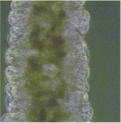
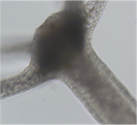
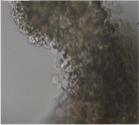
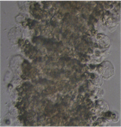
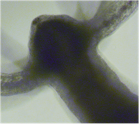
Untreated
HSA/PK15-ECB04
Cell blebbing
Tentacular cell blebbing
